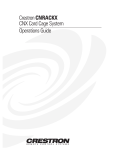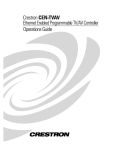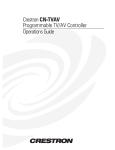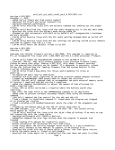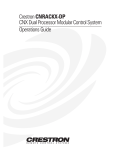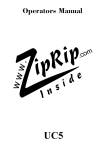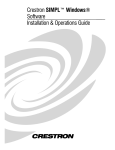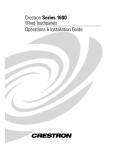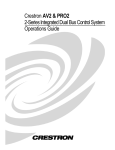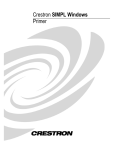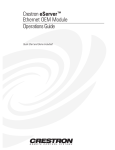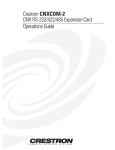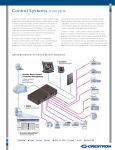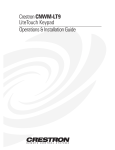Download Crestron CNMSX-PRO Specifications
Transcript
Crestron CNMSX Integrated Control System Contents Integrated Control System: CNMSX 1 Description................................................................................................................................. 1 Functional Description ................................................................................................ 1 Configuration Differences........................................................................................... 1 Physical Description.................................................................................................... 2 Leading Specifications............................................................................................................... 9 Setup ........................................................................................................................................ 11 Rack Mounting .......................................................................................................... 11 Bussing Strip Installation .......................................................................................... 12 Network Wiring......................................................................................................... 12 Hardware Hookup ..................................................................................................... 14 Programming the LCD Display (available on CNMSX-PRO only)........................................ 15 Front Panel Editor ..................................................................................................... 15 Creating a Page with Front Panel Editor ................................................................... 16 Object Types ............................................................................................................. 18 Loading Crestron Control Software......................................................................................... 18 Installing Crestron Development Tools..................................................................... 18 Memory ..................................................................................................................... 19 Initial Setup ............................................................................................................... 19 File Types .................................................................................................................. 21 Obtaining Communications....................................................................................... 24 Troubleshooting Communications ............................................................................ 26 Loading the System Program .................................................................................... 29 Testing the Permanent Memory Image ..................................................................... 30 Loading Touchpanels ................................................................................................ 30 Updating the Control System .................................................................................... 31 Special Consideration for Updating the Control System........................................... 33 Problem Solving ...................................................................................................................... 33 Possible Problems with the CNMSX ........................................................................ 33 Serial Communication Difficulties with Other Devices Connected to the CNMSX. 34 Further Inquiries........................................................................................................ 36 Future Updates .......................................................................................................... 36 Software License Agreement................................................................................................... 37 Return and Warranty Policies.................................................................................................. 39 Merchandise Returns / Repair Service ...................................................................... 39 CRESTRON Limited Warranty ................................................................................ 39 Operations Guide - DOC. 8118B Contents • i Crestron CNMSX Integrated Control System Integrated Control System: CNMSX Description Functional Description The CNMSX is an integral part of Crestron’s new generation of control system technology featuring the newest series of Ethernet/local area network (LAN) compatible control systems. The CNMSX is an integrated control system with eight infrared (IR)/serial ports, six bidirectional RS-232/422/485 ports, eight digital/analog input and digital output ports, eight isolated relays, and an integrated 110/220 VAC (75W) power supply. Expansion Slots There is also room for growth; the unit (depending on configuration) offers four expansion slots. One of the slots features Crestron’s exclusive Direct Processor Access (DPA) port for Ethernet/LAN expansion of the control network. This port provides high-speed access directly to the processor while maintaining bandwidth network connections. The DPA currently supports the CNXENET (& CNXENET+) 10 BaseT Ethernet cards with future support for Firewire, ATM, 100BaseT, and popular interfaces. The other three card slots offer system expansion with a variety of plug-in cards. LCD Display (available on CNMSX-PRO only) An 80-character (two 40-character lines) liquid crystal display (LCD) display and an extended bank of LED indicators are located on the front panel to provide extended features, status information, and troubleshooting indications. Configuration Differences There are two CNMSX configurations available: the PRO and AV. The PRO is the flagship product in Crestron’s new generation of control systems. It is the model that has all the features mentioned in the previous section. The AV is a cost-competitive alternative to the PRO. The AV has all the features of the PRO, except for the extended bank of status and activity LEDs, front panel LCD screen, and the network analyzer feature. A “card cage” (CNXCAGE) providing three expansion slots is Operations Guide - DOC. 8118B Integrated Control System: CNMSX • 1 Integrated Control System Crestron CNMSX optional on the AV. Refer to the table below for a concise list of configuration features. CNMSX Configuration Differences FEATURES CNMSX-PRO CNMSX-AV Integrated 110/220 VAC Power Supply Standard Standard 2 Crestron Network Ports Standard Standard 8 Isolated Relays Standard Standard 8 IR/Serial Ports Standard Standard 6 Bidirectional RS-232/422/485 Ports Standard Standard 8 Digital/Analog Input & Digital Output Ports Standard Standard 2 Computer (RS-232) Ports Standard Standard Direct Processor Access (DPA) Slot Standard Standard Expansion Slots Standard Optional CNXENET or CNXENET+ (field installed into DPA slot) Optional Optional Reverse LCD Display Standard Not Available Extended Bank of Status and Activity LEDs Standard Not Available COM Analyzer Standard Not Available Physical Description An asterisk (*) indicates that the feature is not standard (though may be optional) on the AV configuration. The CNMSX is housed in a black enclosure with silk-screened labels on the front and rear panels. On the front panel there is a single RS-232 computer port, standard LEDs, two reset buttons, a reverse LCD display* with menu function and selection buttons, and an extended bank of LED indicators*. The front panel of the CNSMXPRO and AV are shown below. CNMSX-PRO Front Panel 3.469 in (8.811 cm) 19.000 in (48.260 cm) WITH OPTIONAL MOUNTING EARS 17.025 in (43.244 cm) WITHOUT OPTIONAL MOUNTING EARS CNMSX-AV Front Panel 3.469 in (8.811 cm) 19.000 in (48.260 cm) WITH OPTIONAL MOUNTING EARS 17.025 in (43.244 cm) WITHOUT OPTIONAL MOUNTING EARS An asterisk (*) indicates that the feature is not standard (though may be optional) on the AV configuration. Located on the rear panel, shown on the next page for each configuration, there are three open card slots*, two network connectors, DPA slot, a single RS-232 computer port, eight IR/serial ports, eight I/O ports, eight relay ports, six COM ports, and a 110/220 VAC male connector for power. 2 • Integrated Control System: CNMSX Operations Guide - DOC. 8118B Crestron CNMSX Integrated Control System CNMSX-PRO Rear Panel with Optional DPA Expansion Card and Rack Mounting Ears Installed CNMSX-AV Rear Panel with Optional DPA Expansion Card and Rack Mounting Ears Installed Rubber feet are supplied and can be attached to the base of the unit for stability and to prevent slippage when resting on a flat surface. The unit may also be rack mounted by attaching metal flanges, also known as ears (supplied), to each end. CNMSX Ports A number of ports are provided on the front and rear panels of the CNMSX. Refer to the description of each below. CRESNET CRESNET 4-Wire and 6-Pin Connectors On the rear panel there are two network connectors: 4-wire and modular. The 4-pin male connector (typical Crestron network port labeled 24 Y Z G) and 6-wire RJ-type connector are used for expansion to Cresnet and SmarTouch peripherals. Depending on the expansion slot load, there is a 50 W maximum load rating. The ports are wired in parallel. NOTE: If using the 4-wire connector, review the latest revision of the network interconnection drawing (Doc. 5411). NOTE: If using the modular connector, review the latest revision of the Network Modular Cable Requirements (Doc. 5682). Most 4-conductor phone cables are wired in a crisscross fashion and are not compatible with Crestron equipment. The documents mentioned in the two preceeding notes can be obtained from the Downloads page (CABLES and MANUAL Libraries) of the Crestron website (www.crestron.com). Search for the CRESNET.PDF and MODULAR.PDF files. Operations Guide - DOC. 8118B Integrated Control System: CNMSX • 3 Integrated Control System Crestron CNMSX RELAY OUTPUT Relay Output Connector On the rear panel there are eight normally open, isolated relays. Each relay is rated 1A, 30 VAC/DC; MOV arc suppression is provided across contacts for use with “real world” loads. I/O I/O Connector On the rear panel there are eight software programmable analog and digital inputs as well as digital outputs. Digital outputs offer 250mA sync from maximum 24 VDC; catch diodes for use with “real world” loads. Digital inputs are rated 0 - 24 VDC, 20K ohms input impedance, logic threshold 1.25 VDC. Analog inputs are rated 0 - 10 VDC, protected to 24 VDC maximum, 20K ohms input impedance; pinprogrammable 2K ohms pullup resistor to +5V. INFRARED - SERIAL - RS 232 Infrared - Serial Output Connector On the rear panel there are eight serial outputs for IR, one-way RS-232, or serial interface. Each output is labeled S (signal) and G (ground). Infrared output is rated up to 1.2 MHz. Serial protocols include RS-232. NOTE: RS-232 levels on the infrared – serial output connectors provide a 0 – 5V range, which may not be compatible with all devices. COM (A - F) COM (A - F) Connectors On the rear panel there are six software programmable bidirectional serial ports for RS-232, RS-422, or RS-485 communication with hardware and software handshaking. Speeds are rated up to 230,400 bps. NOTE: The pinout of each 9-pin port is non-standard (refer to table after this note, titled “Non-Standard COM Pinout” ); it contains RS-422 pins in addition to RS-232. 4 • Integrated Control System: CNMSX Operations Guide - DOC. 8118B Crestron CNMSX Integrated Control System This may result in a conflict with some equipment and therefore do not use all nine pins. Only the required pins for each communication type should be connected. NOTE: To support RS-485, tie pin 1 (RXD-) to pin 9 (TXD-) and pin 4 (TXD+) to pin 6 (RXD+) in the cable (refer to table after this note, titled “COM Pinout to RS485 Bus”. Non-Standard COM Pinout PIN DIRECTION 1* 2 3 4 5 6 7 8 9 To CNMSX To CNMSX From CNMSX From CNMSX To CNMSX From CNMSX To CNMSX From CNMSX DESCRIPTION (RXD-) RS-422 Receive Data (Idles low) (RXD) RS-232 Received Data (TXD) RS-232 Transmitted Data (TXD+) RS-422 Transmit Data (Idles high) RS-232 and RS-422 Signal Common (RXD+) RS-422 Receive Data (Idles high) (RTS) RS-232 Request to Send (CTS) RS-232 Clear to Send (TXD-) RS-422 Transmit Data (Idles low) Where: *= RS-422 transmit and receive are balanced signals requiring two lines plus a ground in each direction. RXD+ and TXD+ should idle high (going low at start of data transmission). RXDand TXD- should idle low (going high at start of data transmission). If necessary, RXD+/RXDand TXD+/TXD- may be swapped to maintain correct signal levels. COM Pinout to RS-485 Bus COM (DB9) CONNECTOR RS-485 BUS Tie Pins 1 & 9 Tie Pins 4 & 6 Pin 5 + G COMPUTER Computer Connectors These 9-pin DB9 female connectors (one on front panel and one on rear) are used when programming with a PC. Each port is modem compatible. The modem cable is not included. 100 - 250V ~ 2.3A 50/60 Hz (Power Supply) Universal Power Supply Connector On the rear panel there is an internal universal power supply connector. Use the supplied power cord to connect to an AC outlet. Operations Guide - DOC. 8118B Integrated Control System: CNMSX • 5 Integrated Control System Crestron CNMSX CNMSX Indicators A number of indicators are provided on the front panel of the CNMSX. Refer to the description of each below. PWR This LED illuminates when the unit is connected to and receives power from an AC outlet. NET This LED illuminates when the central processing unit (CNXPU) is processing or communicating with system hardware (i.e., button pressed at local panel or network panel, data being sent out serial port, or permanent memory image being created). ERR This LED illuminates when an error condition is detected by the CNXPU. This may be the result of hardware or software failure, hardware incompatibility with software definitions, or a programming error. To decipher content, examine the message available from the menu function buttons. NOTE: The next four LEDs are active only if the DPA Expansion Card (which is field installed) occupies the DPA slot. TXD (LAN) This LED illuminates during transmission of ethernet data from the DPA slot. RXD (LAN) This LED illuminates during reception of ethernet data by the DPA slot. LNK (LAN) This LED illuminates when there are attachements to the ethernet network. ERR (LAN) This LED illuminates when an ethernet protocol error is detected. NOTE: The remaining LEDs mentioned after this note are available on the PRO configuration, but not available on the AV configuration. COM TX (A - F) These LEDs illuminate during transmission of data to serial devices attached to respective COM ports. COM RX (A - F) These LEDs illuminate during reception of data from serial devices attached to respective COM ports. COM RTS (A - F) These LEDs illuminate to reflect the state of RTS (A - F). An illuminated LED means that the RTS line is high. If no handshaking is specified, the RTS line will be high and therefore, the associated LED is also high. When RTS flow control is enabled, RTS indicates the unit is ready to receive data from serial devices attached to respective COM ports. 6 • Integrated Control System: CNMSX Operations Guide - DOC. 8118B Crestron CNMSX Integrated Control System COM CTS (A - F) These LEDs illuminate to reflect the state of CTS (A - F). An illuminated LED means that the CTS line is high. When CTS flow control is enabled, CTS indicates the serial devices on the respective COM ports are ready to accept data from the unit. IR - SERIAL (A - H) These LEDs illuminate during activity on respective IR/SERIAL lines. INPUT - OUTPUT (1 - 8) These LEDs illuminate when the input voltage threshold for respective I/O ports are exceeded or when the output is active. RELAY (1 - 8) These LEDs illuminate when respective relay is closed. SLOT (1 - 3) These LEDs illuminate when a CNX expansion card is inserted into respective slots. CNMSX Buttons Two buttons are provided on the front panel of the CNMSX. Refer to the description of each below. HW-R Depression of this button initiates physical reset of the system. SW-R Depression of this button in combination with the HW-R button (as described in step 5 of "Troubleshooting Communications" on page 26) performs an overload/reset. CNMSX LCD Display The front panel of the CNMSX-PRO incorporates a reverse mode (yellow on black) LCD display, shown below. The screen contains two lines with 40 characters per line; it is used to extend features and gain access to the system including the SIMPL program. To the right of the display are four menu selection buttons. These buttons permit the user to navigate through the menus and also to control the brightness of the display backlight. Below the display are six menu function buttons. These buttons offer extended features of the CNMSX. For details, refer to "Programming the LCD Display (available on CNMSX-PRO only)" on page 15. Main Menu (Default LCD Display) Operations Guide - DOC. 8118B LCD Display with Menu Selection and Menu Function Buttons Integrated Control System: CNMSX • 7 Integrated Control System Menu Selection Buttons Crestron CNMSX MENU This menu selection button functions as a return and will eventually bring the screen display to the menu default state. This button scrolls the listed information UP. This button scrolls the listed information DOWN. BKLT This button adjusts the brightness of the LCD backlight and the front panel LEDs. Menu Function Buttons PANEL This menu function button displays a programmable interface offering command text, indirect text, and hierarchical screen structure. The menu contents are subject to programming and an example of this display is provided in "Programming the LCD Display (available on CNMSX-PRO only)" on page 15. INFO This button displays a default Info Menu, shown below. System information, including the loaded SIMPL program version, types of CNX expansion cards installed in the card slots, the Cresnet devices detected, the Ops/ROM version, and the communication settings, is displayed. Default Info Menu MSG This button displays system error messages or alarms. If there are one or more errors, press the menu selection button to reveal the next message. NOTE: Error messages may be the result of hardware or software failure, hardware incompatibility with software definitions, or a programming error. After the last message has been read, the ERR front panel LED extinguishes. Example Message 8 • Integrated Control System: CNMSX Operations Guide - DOC. 8118B Crestron CNMSX Integrated Control System TIME This menu can only be obtained by entering the correct access code. The default access code is 1234. Use the Viewport (Functions | Set CNX Front Panel Password) to assign a unique access code. The default Time Menu, shown after this paragraph, permits alterations to system date and time. Selecting a date/time parameter from the menu increments it by one. Additional incremental or decremental changes can then be done by depressing the and menu selection buttons, respectively. Default Time Menu COM This button monitors the transmission and reception traffic on each COM port for a given data format, as shown below in the default COM Menu. For more details refer to "Network Analyzer (available on CNMSX-PRO only)" on page 34. Default COM Menu Leading Specifications The tables below and on the next page provide a summary of leading specifications for the CNMSX. Dimensions and weight are rounded to the nearest hundredth unit. Leading Specifications of the CNMSX SPECIFICATION Power Requirements SIMPLTM Windows® CNX Upgrade File (.upz) Reset Buttons DETAILS 100-250 VAC, 2.3 A, 50/60 Hz Internal Universal Power Supply Version 1.30.01 or later with the addition of smwlib49.exe Version 5.10.24X or later.2 HW-R (permits physical reset of system) & SW-R (assists with overload/reset). 1 2 Operations Guide - DOC. 8118B The latest software versions can be obtained from the Downloads page (SIMPLWIN Library) of the Crestron website (www.crestron.com). New users are required to register in order to obtain access to the FTP site. Filenames for CNX upgrades have a UPZ extension and can be obtained from the Downloads page (OPSYS Library) of the Crestron website. For a CNMSX with e-control™ use the latest UPZ upgrade file from the ECONTROL Library. Integrated Control System: CNMSX • 9 Integrated Control System Crestron CNMSX Leading Specifications of the CNMSX (Continued) SPECIFICATION LCD Display DETAILS (1) reverse mode (yellow on black) LCD back light; (2) lines, MaxDigitalSignals MaxAnalogSignals MaxNVRAM MaxProgramSize Dimensions & Weight (40) characters per line.3 16373 2048 64K 256K (no DPA card installed, CNXENET+ card installed, or CNXENET installed and its IP Address set to 0.0.0.0) 100K (CNXENET card installed with valid IP Address)4 Height: 3.47 in (8.81 cm) Width: 19.00 in (48.26 cm) Depth: 8.43 in (21.41 cm) Weight: 6.29 lb (2.85 kg) for AV Weight: 7.01 lb (3.18 kg) for PRO NOTE: There is no restriction with the CNXENET+ card. 3 The LCD display is not available on the CNMSX-AV. 4 The program size restriction of 100K with the CNXENET card exists if the control system has the CNXENET installed and a valid IP address is assigned. SIMPL Windows limits the size of the compiled file to 100K only if the CNXENET has been dropped onto the DPA Card slot. Typically, if the CNXENET is being used for remote maintenance and not for programming Ethernet devices (such as e-control touchpanels, etc), most users do not drop the CNXENET into the program in SIMPL Windows. Please note that the maximum program size is still 100K, even though SIMPL Windows states 256K during a compile. To make SIMPL Windows enforce the restriction, drop a CNXENET into the DPA Card slot. Leading Specifications of the CNMSX Connectors CONNECTOR NET DETAILS (1) 6-wire RJ-type connector and (1) 4-pin male connector for expansion to CRESNET or SmarTouch peripherals. 50 Watt maximum load depending on expansion slot load RELAYS (8) normally open,isolated relays; each relay is rated 1 A, 30 VAC/DC MOV arc suppression devices across contacts for use with "real world" loads INPUT/OUTPUT (8) programmable digital/analog inputs & digital outputs; digital outputs offer 250 mA sync from maximum 24 VDC; catch diodes for use with "real world" loads; digital inputs rated for 0-24 VDC, 20 K ohms input impedance, logic threshold 1.25 VDC; analog inputs rated 1-10 VDC, protected to 24 VDC maximum, 20 K ohms input impedance; programmable 2 K ohms pullup resistor (per pin, software reference to GND or closure to GND) IR/SERIAL (8) serial outputs or IR, RS-232, or serial interface; signal (S) and ground (G) pins, infrared output up to 1.2 MHz, serial protocols include RS-232 COM (6) bidirectional serial ports for RS-232, RS-422, or RS-485 communication with hardware and software handshaking; speeds up to 230,400 bps COMPUTER (2) 9-pin DB9 female connector for programming with a PC; modem compatible, null modem cable; not included Leading Specifications of the CNMSX Slots SLOT 1 through 3 DPA DETAILS (3) open "card cage" slots accept any "X" CRESNET control card5 Direct Processor Access expansion slot for optional local area network (LAN) interface card; CNXENET+ requires field installation and has (1) 8-wire RJ45 connector for communication acces 5 CNXCAGE, 3-card cage, installation required for CNMSX-AV. 10 • Integrated Control System: CNMSX Operations Guide - DOC. 8118B Crestron CNMSX Integrated Control System As of the date of manufacture, the unit has been tested and found to comply with specifications for CE marking. NOTE: This device complies with part 15 of the FCC rules. Operation is subject to the following two conditions: (1) this device may not cause harmful interference, and (2) this device must accept any interference received, including interference that may cause undesired operation. Setup Rack Mounting WARNING: To prevent bodily injury when mounting or servicing this unit in a rack, take special precautions to ensure that the system remains stable. The following guidelines are provided to ensure your safety: The unit should be mounted at the bottom of the rack if it is the only unit in the rack. When mounting this unit in a partially filled rack, load the rack from the bottom to the top with the heaviest component at the bottom of the rack. If the rack is provided with stabilizing devices, install the stabilizers before mounting or servicing the unit in the rack. NOTE: If rack mounting is not required, rubber feet are provided for table-top mounting or stacking. Apply the feet near the corner edges on the underside of the unit. NOTE: Reliable earthing of rack mounted equipment should be maintained. Particular attention should be given to supply connections other than direct connections to the branch circuit. (e.g., use of power strips). Two “ears” are provided with the CNMSX so that the unit can be rack mounted. These ears must be installed prior to mounting. Complete the procedure below to attach ears to CNMSX. The only tool required is a #2 Phillips screwdriver. Operations Guide - DOC. 8118B 1. There are 12 screws (#6-32 x 0.375" LG) that secure the sides of the CNMSX top cover. Using a #2 Phillips screwdriver, remove the three screws closest to the front panel from one side of the unit. 2. Position a rack ear so that its mounting holes align with the holes vacated by the screws in step 1. 3. Secure the ear to the CNMSX with three screws from step 1, as shown on the next page. Integrated Control System: CNMSX • 11 Integrated Control System Crestron CNMSX Ear Attachment for Rack Mounting FASTEN WITH THE SAME (3) COVER SCREWS LEFT SIDE VIEW OF CNMSX-PRO/AV WITH OPTIONAL RACK MOUNTING EARS INSTALLED 4. Repeat procedure (steps 1 through 3) to attach remaining ear to opposite side. Bussing Strip Installation The CNMSX is supplied with a brass bussing strip to facilitate commoning (linking) of multiple terminal block connections. The bussing strip is constructed with eight terminal block position, and may be trimmed to size for various applications or different devices. One strip is supplied for each 16-position terminal block. 1. To utilize the bussing strip, determine the number of relays to be commoned for the equipment being installed. If less than eight, the strip can be trimmed to size with a pair of scissors or wire snips. 2. Loosen the terminal block screws and insert the first leg of the bussing strip into the first common position on the terminal block. The strip engages the other common positions automatically. 3. Remove approximately 1/8" of the jacket from the common wire and insert the conductor into one of the terminal block common positions. Tightenthe terminal block screws to lock the wire and bussing strip into place. Insulate the strip by folding a piece of ¾" wide vinyl electrical tape (such as Scotch 33+) over the spine and as much of the individual legs as possible. Excess tape at each end of the strip should be pressed closed, then trimmed to within approximately 1/16" of the end of the strip. 4. When wiring the remaining conductors, remove approximately 1/8" of the jacket and insert the wires into the proper terminal block positions. To prevent the possibility of electrical shorts, it is essential that these conductors do not touch any uninsulated portion of the bussing strip. 5. Securing a tie wrap around the bussing strip is a useful way to strain relieve the wires connected to the terminal block. Network Wiring When calculating the wire gauge for a particular network run, the length of the run and the power factor of each network unit to be connected must be taken into consideration. If network units are to be daisy-chained on the run, the power factor of each network unit to be daisy-chained must be added together to determine the power factor of the entire chain. The length of the run in feet and the power factor of the run should be used in the following resistance equation to calculate the value on the right side of the equation. 12 • Integrated Control System: CNMSX Operations Guide - DOC. 8118B Crestron CNMSX Integrated Control System Resistance Equation R < 40,000 L x PF Where: R = Resistance (refer to table below). L = Length of run (or chain) in feet. PF = Power factor of entire run (or chain). The required wire gauge should be chosen such that the resistance value is less than the value calculated in the resistance equation. Refer to the table after this paragraph. Wire Gauge Values RESISTANCE (R) WIRE GAUGE 4 16 6 18 10 20 15 22 13 Doubled CAT5 8.7 Tripled CAT5 NOTE: All network wiring must consist of two twisted-pairs. One twisted pair is the +24V conductor and the GND conductor and the other twisted pair is the Y conductor and the Z conductor. NOTE: When daisy-chaining Cresnet units, strip the ends of the wires carefully to avoid nicking the conductors. Twist together the ends of the wires that share a pin on the network connector, and tin the twisted connection. Apply solder only to the ends of the twisted wires. Avoid tinning too far up the wires or the end becomes brittle. Insert the tinned connection into the Cresnet connector and tighten the retaining screw. Repeat the procedure for the other three conductors. Four-Pin Network Connector For four-pin network cable connections in a Crestron remote control system, the Cresnet cable is used to power Crestron devices. Before making any four-pin network connections to the CNMSX, refer to the network interconnection after this paragraph. Recommended Network Cable, Liberty Wire Reference: Cresnet TO CONTROL SYSTEM SHIELD BLACK RED TO NETWORK DEVICE G Z Y 24 24 Y Z G FRONT VIEW FRONT VIEW TWISTED PAIR A TWISTED PAIR B RED WHITE BLUE BLACK BLUE WHITE RECOMMENDED COLOR CODE GND (-) Z (+) Y 24 = = = = BLACK BLUE WHITE RED TO OTHER NETWORK DEVICE PAIR A PAIR B REFER TO LATEST REVISION OF DOC. 5411. 24 Y Z G Modular Network Connector For modular cable connections in a Crestron remote control system, the six-conductor modular cable is used to power Crestron devices. That cable must be rated for 30 Operations Guide - DOC. 8118B Integrated Control System: CNMSX • 13 Integrated Control System Crestron CNMSX VDC, 140°F (60°C) minimum. Also, the cable must be rated to carry sufficient current for the loads. UL style 20251cable can be used to carry up to 2A when used in a dual power and dual ground configuration, as shown below. Crestron Network Modular Cable Requirements 6-CONDUCTOR MODULAR CABLE MODULAR CONNECTOR (6-POSITION, 6-CONTACT) MODULAR CONNECTOR (6-POSITION, 6-CONTACT) PIN ORIENTATION #1 PIN TO PIN WIRING 1 2 +24V +24V Y 3 4 5 6 Z GND GND 1 2 3 4 5 6 NOTE: Most 6-conductor phone cables are wired in a crisscross fashion and are not compatible with Crestron equipment. Hardware Hookup Refer to the hookup diagram on the next page and aside from attaching power last, complete the connections in any order. NOTE: Refer to the latest revision of the Crestron Network Modular Cable Requirements (Doc. 5682) or Network Interconnect Drawing (Doc. 5411) when making connections to the port labeled CRESNET. These documents can be obtained from the Downloads page (CABLES and MANUAL Libraries) of the Crestron website (www.crestron.com). Search for the MODULAR.PDF and CRESNET.PDF files, respectively. NOTE: To prevent overheating, do not operate this product in an area that exceeds the recommended ambient temperature of 104°F (40°C). Consideration must be given if installed in a closed or multi-unit rack assembly since the operating ambient temperature of the rack environment may be greater than the room ambient. Contact with thermal insulating materials should be avoided on all sides of the unit. NOTE: The maximum continuous current from equipment under any external load conditions shall not exceed a current limit that is suitable for the minimum wire gauge used in interconnecting cables. The ratings on the connecting unit's supply input should be considered to prevent overloading the wiring. NOTE: Since the plug on the power supply cord is used to disconnect power from the unit, the socket-outlet shall be installed near the equipment and shall be easily accessible. 14 • Integrated Control System: CNMSX Operations Guide - DOC. 8118B Crestron CNMSX Integrated Control System Hookup Connections for CNMSX TO CONTROLLABLE DEVICES TO ANY STS OR CRESNET NETWORK DEVICE TO ETHERNET OR LOCAL AREA NETWORK (IF DPA EXPANSION CARD HAS BEEN INSTALLED) TO CNXIRP OR SERIAL DEVICES FROM DEVICE OUTPUTS - CONTACT CLOSURES - SOLID STATE CLOSURES TO ANY RS-232, -422, OR -485 DEVICE TO CONTROLLABLE DEVICES TO SERIAL PORT ON PC (ANOTHER DB9 CONNECTOR ON FRONT PANEL) TO OUTLET (POWER CORD SUPPLIED) Programming the LCD Display (available on CNMSX-PRO only) NOTE: The following description assumes that the reader has some knowledge of SIMPL™ Windows®. If not, please refer to the extensive help information provided with the software. SIMPL (Symbol Intensive Master Programming Language) is an easy-to-use programming language that is completely integrated and compatible with all Crestron system hardware. The objects that are used in SIMPL are called symbols. SIMPL Windows offers drag and drop functionality in a familiar Windows® environment. SIMPL Windows is Crestron Electronics development environment for programming Crestron control systems. It provides a well-designed graphical environment with a number of workspaces (i.e., windows) in which a programmer can select, configure, program, test, and monitor a Crestron control system. The CNMSX-PRO LCD display is preprogrammed with a certain level of diagnostic, testing, and network device information. Assuming the CNMSX is connected to a PC running SIMPL Windows, a LCD display programming utility (Front Panel Editor) can be accessed. This editor enables a programmer to program multi-level pages under the PANEL (left-most, function) button on the LCD display. Front Panel Editor The LCD display on a CNMSX-PRO has different pages that are defined by the programmer. Menu function buttons are assigned to different pages or objects. The LCD display has a 2x40 character display with six-programmable buttons. In Front Panel Editor, pages are designed and added to the panel. An example of the default page is shown after this paragraph. Each front page is one display (2x40 characters) and can have as many objects as the physical size of the display allows (objects can not overlap). The top line of the panel is used for informative object displays, such as headings, indirect text, bar graphs, and time/date displays. The bottom line of the panel is for objects that are accessed by the six menu function buttons below the display. The buttons only access the page or object whose field is directly over the button. Objects added to the bottom line of the display can have page Operations Guide - DOC. 8118B Integrated Control System: CNMSX • 15 Integrated Control System Crestron CNMSX jumps or logic programming in SIMPL Windows that cause specific events to occur. These objects are initiated by pressing the function button that is associated with it. Default Front Panel Page Creating a Page with Front Panel Editor NOTE: The creation of a front panel page is discussed in this section. For more details, consult the SIMPL Windows help file. Search for Front Panel Editor. Assume that a page, as shown below, is required. The concept of such an application is that the user can then choose a given device and then, from a lower-level page, control one or more transport functions of the device. Example of a Front Panel Page Adding Top-Level Pages and Objects Use SIMPL Windows and access the Front Panel Editor by selecting Project | Edit Front Panel. Click on the Add button and enter a new name for the new page. For this example, use “Menu1 – Choose Device” as the name. Double click inside the display area of the front panel on the screen to open the “Edit Panel Object” dialog box. This example requires that headings be added to the page, so choose Text Object from the Object Type area. In the Inactive Text field, enter “Choose device”. The object is displayed on the panel. Click on and drag the object to its desired location on the panel, top row. Add additional objects (VCR, LaserDisc, CD, Lights, and Volume) to the page by double clicking in the display area where the object is to appear. Repeat the procedure in the previous paragraph; place objects over the appropriate menu function button. Adding Lower-Level Pages and Objects Lower-level pages can be added for each of the objects on the bottom row of the page just created. For the purposes of this example, one lower-level page is added for the VCR object. Simply click on the Add button and enter a new name for the new page. For this example, use “Menu2 – VCR Control” as the name. Return to the “Menu1 – Choose Device” and double click on the VCR object. The “Edit Panel Object” dialog box appears. From the Menu Jump field, select “Menu2 – VCR Control” and click OK. Select the Simulate check box to make the Front Panel 16 • Integrated Control System: CNMSX Operations Guide - DOC. 8118B Crestron CNMSX Integrated Control System Editor simulate an actual CNMSX-PRO front panel. Click on the VCR function button to enable the simulated page jump. The display clears, because “Menu2 – VCR Control” has been named, but no objects have been added yet. An example VCR Control page, as shown below, has a text object that appears as a header on the top row of the display and objects that are control functions assigned to each function button. Objects in the bottom row are shown in the inactive state (none of the buttons are being pressed). Example VCR Control Page Use the “Edit Panel Object” dialog box to add objects to this page. Double click on the first object, play. From the Digital Channel field in the “Edit Panel Object” dialog box, scroll down to or enter “1”. In the Active Text field, enter “PLAY” as the button’s active text. Therefore, when the menu function button associated with digital channel 1 (the VCR button) is pressed, the active text is displayed as a visual cue that the button is pressed. Do the same procedure for each of the other menu function buttons in the “Menu2 – VCR Control” page. NOTE: Digital channels are also referred to as “join numbers”. Join numbers are numeric identifiers assigned to an object or button. It is necessary to identify objects so the input/output signals of the SIMPL program can be named and routed properly. Front Panel Symbol A powerful tool to assist programmers in naming and routing signals for the LCD display is the Synchronize Signals command. While the panel appears on the PC screen, select Panel | Synchronize Signal Names to automatically name all the input and output signals for the front panel in the SIMPL Windows program. To display the signal names, double click on Slot-08 : CNX LCD Front Panel which is available from the Central Control Modules folder in the Program View of SIMPL Windows’ Program Manager. The symbol appears in Detail View, as shown after this paragraph. Front Panel Symbol Displayed in SIMPL Windows’ Detail View of Programming Manager Operations Guide - DOC. 8118B Integrated Control System: CNMSX • 17 Integrated Control System Crestron CNMSX Object Types The sample discussed in the previous sections utilizes only one of the object types available from the “Edit Panel Object” dialog box, shown below. These object types are not new to Crestron programmers; the same types are available in VisionTools™ Pro-e. For a detailed description of these types refer to the VisionTools™ Pro-e help file. Use the glossary or search function to locate the information. Object Type Area in the “Edit Panel Object” Dialog Box Loading Crestron Control Software Crestron control software is available in an electronic form, via CD-ROM, email, or from the Crestron website (www.crestron.com). Regardless of how and from where the software is obtained, this section provides the necessary installation steps. Before performing the following set of instructions, obtain a straight-through RS-232 cable that has a DB9 male connector on one end and a DB9 female connector on the other. Straight-through means that pin 1 on the male end goes to pin 1 on the female end, etc. The male end plugs into the port labeled COMPUTER on the CNMSX. The female end plugs into a serial port on the PC. If the PC has a DB25 male connector, obtain a DB9 to DB25 adapter (the adapter has a DB9 male end and a DB25 female end). Installing Crestron Development Tools Crestron provides software tools for programming the CNMSX. Even if only the control software is being loaded into the hardware and there are no plans to do any programming, some Crestron development software must be installed on the PC. Currently, Crestron programming is accomplished with the use of the following development tools listed in the table below. NOTE: If the intent is to load software developed by someone else, then install SIMPL Windows only. Install all three applications to program systems as well. NOTE: The latest version of these applications is available from the Crestron website (www.crestron.com). Crestron ControlCD also carries a version (which may not be as current as the website version). To obtain a free copy of the CD-ROM, please call Crestron at 1-888-CRESTRON [1-888-273-7876]. Alternatively, complete a literature request from the Crestron website to obtain one. Crestron Development Tools DEVELOPMENT TOOL DESCRIPTION SIMPLTM Windows® Used to program the main control processor. VisionToolsTM Pro-e Used to design touchpanel layouts and to program SmarTouch Systems. DEALTM for Windows® Used for learning (using the optional CNXLIR) and maintaining IR driver files. 18 • Integrated Control System: CNMSX Operations Guide - DOC. 8118B Crestron CNMSX Integrated Control System Before installing any tools, confirm that all applications such as Microsoft Office, etc. are closed. The website and CD provide instructions for installing the various development tools. When initiating a custom install from the CD, the user is presented with a list of the software programs, documentation, and other resources available on the CD-ROM. For each item, set or clear a checkbox to the left of the item to direct the installation program whether to install that component onto the hard drive. The size of the items installed determines how much hard disk space is required. Each development tool contains a help file that can be opened from the Help pulldown menu. Refer to these files for additional information. Memory The CNMSX has non-volatile and volatile memory. Non-volatile memory contains information that is retained after loss of electrical power. Volatile memory is lost after a power failure. Refer to the lists below for a breakdown of memory for programrelated information stored in the CNMSX. Non-volatile 1. SIMPL+ Modules (always permanent) 2. SIMPL+ Variables 3. SIMPL Program (after written to permanent memory) 4. Ops, Monitor, TCP/IP Stack 5. Signals explicitly written to NVRAM (by symbols such as RAM, RAM2, SMEM, SMEM2, RAMPNV, DRAM, etc.) Volatile 1. Digital, analog and serial signal values 2. SIMPL Program (prior to writing to permanent memory) Initial Setup NOTE: For the Ethernet IP setup of the CNMSX with the optional CNX Ethernet expansion card, refer to the CNXENET or CNXENET+ Operations & Installation Guide (latest revision of Doc. 8129 or 8153, respectively) for further information. To avoid any procedural errors, follow the steps in the order provided. Operations Guide - DOC. 8118B After installing the desired development tool, various job files may be obtained from Crestron or other sources. Using Windows Explorer, complete the following steps. These steps ensure that all job files reside on the hard drive (C:) in a directory named \CRESTRON\PROJECTS\MYJOB. 1. Navigate to the SIMPL directory on the hard drive. Assume that the default install directory is C:\CRESTRON. 2. Create a new folder for the project files. Although the folder where the files are placed is not critical, it is easier to manage projects if a logical structure is created. For example, create a new folder, called PROJECTS, underneath the CRESTRON directory. Create another folder, called MYJOB, under PROJECTS for the current job. The resulting pathname is C:\CRESTRON\PROJECTS\ MYJOB. Integrated Control System: CNMSX • 19 Integrated Control System Crestron CNMSX 3. Copy the supplied files into the folder created in the last step. The source of the file determines the procedure. From a floppy disk: Most floppy disks sent from Crestron contain a common directory structure designed to make it easier to organize files. Copy the entire contents of the disk(s) including the directory structure. From an EXE file: If a job is downloaded from the Crestron website or is received via email, all files may have been compacted into a single, self-extracting archive. This archive has an EXE extension. First, copy the EXE file into the directory stated in step 1, then double click on the file name to begin decompressing the file. The program asks for a location for the extracted files. In this case, simply browse for the same directory where the archive was copied. (Once files are extracted, retain the original EXE file in case files need to be restored at any point.) From a ZIP file: If the downloaded job is from the Crestron website, BBS, or email, all files may have been compressed into a single archive file with a ZIP extension. If the program was created with SIMPL Windows 1.30.01 or later, this file was created with the Copy Program feature of SIMPL Windows, which provides the option to archive the project to a ZIP file. An example dialog box is shown below. Copy Program Dialog Box 4. 20 • Integrated Control System: CNMSX After Begin Copy is selected, the selected files will be archived to the example file C:\CRESTRON\SIMPL\PROGRAMS\EXAMPLE.ZIP. For this ZIP file to be used by SIMPL Windows, select File | Import Archived Program from the Crestron Viewport. This will present a dialog similar to the one one after this paragraph, after selecting the ZIP to import. Operations Guide - DOC. 8118B Crestron CNMSX Integrated Control System "Import an Archived Program" Dialog Box The job may be copied to any folder or directory, and the User IR, Macro, and SIMPL+ files will be copied to the proper directories. If a version of SIMPL Windows lower than 1.30.01 is being used, copy the ZIP file into the job directory stated in step 1, then extract the files with a program called WinZip. Obtain a copy of this program from their website (www.winzip.com) on the internet. Extract the files into the same directory where the archive was copied. Once files are extracted, retain the original ZIP file in case the files need to be restored at any point. The User IR, Macro, and SIMPL+ modules will need to be copied to their proper directories manually. File Types There are quite a few file types involved with Crestron control software. This section is intended to explain the different file types that might be encountered in each directory. In many cases, the supplied software is grouped into a number of subdirectories. The intent is to keep files organized. For example, after copying the files to the hard disk, the directory structure may appear as shown below. Possible Subdirectory Structure NOTE: In this structure, the "VT3501" and "VT3502" directories represent two VT3500 touchpanels that are part of the entire remote control system. Please consult the Operations Guide - DOC. 8118B Integrated Control System: CNMSX • 21 Integrated Control System Crestron CNMSX connection sheets or other supplied information to determine which directory corresponds to a given touchpanel. Ops Subdirectory - The files in this subdirectory contain the CNMSX operating system with which the program was tested. Ensure that the operating system version currently loaded is equal to or newer than the version included here, so that the program runs properly. For help with uploading an operating system, refer to "Updating the Control System" on page 31. File Types in Ops Subdirectory FILE TYPE DESCRIPTION .upz This is a control system file. For more information regarding these files, refer to "Updating the Control System". Programs Subdirectory - The files in this subdirectory (shown on the next page) contain the system program. This is the main program, which loads into the CNMSX and determines the exact functionality of the system. File Types in Programs Subdirectory FILE TYPE DESCRIPTION .asv .bin SIMPL Windows auto-save file. This is the executable code for all CNX control systems. Crestron SIMPL+ archive. This archive contains all of the SIMPL+ executable code (from both user modules and crestron modules) that the Transfer Program dialog will send to the CNMSX. This is the default IP Table that contains the IP addresses of all of the ethernet devices in the system. It is generated when the program is compiled and the CNX control system contains an optional CNXENET+ expansion card and Ethernet devices. This file contains information required by Test Manager (see SIMPL Windows help for more information) for debugging programs in realtime. It is generated each time the program is compiled. SIMPL Windows program backup file. This is the SIMPL-C file that is generated from the SMW file when a program is compiled. In SIMPL Windows version 1.18 or lower, this file is what actually gets compiled into the BIN file. In versions after 1.18, this file may or may not be generated and is not required. This is the SIMPL Windows program file. It contains the source code for the main system program. .csz .dip .sig .sm2 .smp .smw Userdb Subdirectory - The files in this subdirectory are user database infrared (IR) drivers, which are needed to interface with certain IR-controlled devices in the system. These differ from Crestron database IR drivers in that the former are included as part of a Crestron Database release. File Types in Userdb Subdirectory FILE TYPE DESCRIPTION .ir This is a user IR driver file. It is needed during the convert/compile process in order to properly compile the program. If recompilation of the program is necessary, use the Import Program option or copy any IR files received into the default user database directory (see SIMPL Windows help for more information). Alternatively, set the SIMPL Windows userdb directory to the directory where the macros exist. In SIMPL Windows, this is accomplished from the Directories tab by selecting Edit | Preferences. 22 • Integrated Control System: CNMSX Operations Guide - DOC. 8118B Crestron CNMSX Integrated Control System Usrmacro Subdirectory - The files in this subdirectory are user macros, or special sub-programs that are integral parts of the main program. These differ from Crestron macros in that the former are supplied as part of the development software. File Types in Usrmacro Subdirectory FILE TYPE DESCRIPTION .um2 This is the user macro backup file. .umc This is a user macro file. It is needed during the convert/compile process in order to properly compile the program. To recompile the program, use the Import Program option or copy any UMC files received into the default user macro directory (see SIMPL Windows help for more information). Alternatively, set the SIMPL Windows usermacro directory to the directory where the macros exist. In SIMPL Windows, this is accomplished from the Directories tab by selecting Edit | Preferences. UsrSPlus Subdirectory - The files in this subdirectory (shown on the next page) contain the User SIMPL+ modules used in this system. To recompile the program, use the Import Program option or copy the USP and USH files received into the default user SIMPL+ directory. Alternatively, set the SIMPL windows user SIMPL+ directory to the directory where the USP and USH files exist. File Types in UsrSPlus Subdirectory FILE TYPE .uf .usp .ush DESCRIPTION User SIMPL+ compiled file. This contains the executable SIMPL+ code for the CNMSX. User SIMPL+ source code module. This file gets compiled by the SIMPL+ environment and also is editable by the user. User SIMPL+ header file. This file details how SIMPL Windows should model the gate as a symbol (i.e. how many inputs, outputs, etc.). Touchpanel Subdirectory - The files in this subdirectory contain touchpanel projects (for example, “vt3501” and “vt3502” in the previous illustration titled “Possible Subdirectory Structure”). Each project describes the exact graphical nature of the panel to which it uploads. File Types in Touchpanel Subdirectory FILE TYPE DESCRIPTION .bmp, .pcx, These are graphic files that are needed by VTW for recompiling touchpanel projects. or .dib This is the compiled touchpanel project file. This file is uploaded to the .hex panel itself. Logic files for existing SmarTouch products, like ST-1500/1500C, that .lgc use VTW. Logic files for existing SmarTouch products, like ST-1500/1500C or .vti and .vtl ST-1550/1550C that use VTPro-e. This is the only VisionTools Pro-e (VTPro-e) file required for a given project. It replaces the PRJ, PGF, and graphic (BMP, PCX, etc.) files .vtp that were part of VisionTools for Windows (VTW) projects. This is the compiled touchpanel project file for the TPS Series panels .vtz (similar to .hex). Operations Guide - DOC. 8118B Integrated Control System: CNMSX • 23 Integrated Control System Crestron CNMSX Obtaining Communications NOTE: If an optional CNX Ethernet expansion card is installed into the CNMSX, communications can be obtained over TCP/IP. The Operations & Installation Guide for the card explains how to load the required IP Table that contains the addresses of the Ethernet devices and set up the control system for Ethernet communications. Refer to the CNXENET or CNXENET+ Operations & Installation Guide (latest revision of Doc. 8129 or 8153, respectively) for further information. Before attempting to upload the program files into the CNMSX, it is necessary to first establish communication between the CNMSX and a PC. There are two ways of communicating with the CNMSX, either via the COMPUTER port (RS-232 serial communications) or via Ethernet if the optional CNX Ethernet expansion card is installed. Prior to completing the following steps, be sure the communication cable is properly connected as described in "Loading Crestron Control Software" on page 18. 1. Make sure that no programs accessing the COM port of the PC are running. 2. Select Start | Programs | Crestron | SIMPL Windows to start SIMPL Windows. 3. SIMPL Windows responds with an opening splash screen and may display the “What do you want to do?” dialog box. If so, close the dialog box. 4. As illustrated after this step, select Tools | Viewport to open the “Crestron Viewport” dialog box. Accessing the Viewport 5. From the Setup menu, verify that Auto Baud Search is checked; refer to illustration below. Verifying Auto Baud Search 6. 24 • Integrated Control System: CNMSX While the Viewport is displayed, select Setup | Communications settings (alternatively, depress Alt+D) to open the “Port Settings” dialog box. Refer to the illustration on the next page. Operations Guide - DOC. 8118B Crestron CNMSX Integrated Control System Accessing the “Port Settings” Dialog Box 7. Select the appropriate connection type (RS-232 for a PC connection through the COMPUTER port of the CNMSX or TCP/IP through the Ethernet via optional LAN/DPA port). Verify that the proper COM port is selected. Set the baud rate to 38400, the parity to None, the data bits to Eight, and the stop bits to One. Refer to the dialog box shown after this step for the remaining settings. Click on the OK button to save the communication settings and close the dialog box. “Port Settings” Dialog Box Operations Guide - DOC. 8118B Integrated Control System: CNMSX • 25 Integrated Control System Crestron CNMSX 8. Select Diagnostics | Check Operating System Version (alternatively, depress the F5 key) from the Viewport. The Viewport may display a window as it scans various baud rates. Eventually, a message should appear in the Incoming section showing a version number. Such a response indicates that communications have been established. If a “No Communications with Rack” error message appears, proceed to "Troubleshooting Communications" on page 26. 9. If the baud rate of the CNMSX was something other than 38400, then the software automatically adjusts the baud rate to 38400. Troubleshooting Communications NOTE: This section covers troubleshooting communications of the CNMSX via RS232 to the COMPUTER port. For troubleshooting Ethernet communications of the CNMSX with the optional CNX Ethernet expansion card, refer to the CNXENET or CNXENET+ Operations & Installation Guide (latest revision of Doc. 8129 or 8153, respectively) for further information. If communications with the CNMSX was not established, follow the steps in this section to help remedy the problem. After performing each step, repeat step 7 in "Obtaining Communications" on page 24 again. 1. Try repeating step 7 from "Obtaining Communications" on page 24 to attempt to establish communications. 2. Verify that the cable being used is correct. It should be a straightthrough cable. That is, pin 1 on one end is connected to pin 1 on the other end. Pin 2 connects to pin 2, etc. To work properly, pins 2, 3, and 5 must be connected. 3. Verify that the proper COM port on the PC has been selected. Some computers have more than one COM port; some of which may be internal (e.g., for a modem). If verification can not be made, consult the user’s manual or contact the PC manufacturer. 4. Check the ERR LED on the front of the CNMSX. If the LED is illuminated, unplug the unit and reapply power after a few seconds. If the LED illuminates again, call Crestron technical support. Refer to "Further Inquiries" on page 36. 5. If steps 1 through 4 have failed to result in communications, the last series of steps to perform is an overload/reset on the control processor. Complete the following steps to do so. 5a. While the Viewport is displayed, select Setup | Communications Settings (alternatively, depress Alt+D) to open the “Set Baud Rate” dialog box. 26 • Integrated Control System: CNMSX Operations Guide - DOC. 8118B Crestron CNMSX Integrated Control System Accessing the Set Baud Rate Dialog Box 5b. Set the baud rate to 9600, as shown below. Changing the Baud Rate from the “Set Baud Rate” Dialog Box 5c. Set the CNMSX to 9600 baud. - Depress and hold the SW-R button on the CNMSX front panel. - Depress and release the HW-R button on the CNMSX front panel. - Wait until a message similar to the one below appears in the Viewport. Viewport Message Operations Guide - DOC. 8118B Integrated Control System: CNMSX • 27 Integrated Control System Crestron CNMSX NOTE: If a computer is not hooked up, wait approximately three to four seconds. - Release the SW-R button. 5d. If the CNMSX responds, proceed to step 5e. Otherwise, do the following. - Remove power from the CNMSX. - Depress and hold the SW-R button on the CNMSX front panel. - Reapply power to the CNMSX. - Wait until a message similar to the one below appears in the Viewport. Viewport Message NOTE: If a computer is not hooked up, wait approximately three to four seconds. - Release the SW-R button. 5e. Text messages, as shown below, should appear on the Incoming window of the Viewport. If messages do not appear or they are illegible, verify that the Viewport is set to 9600 baud and repeat steps 5a through 5d. If data similar to that shown below appears, perform steps 7 through 11 in "Obtaining Communications" on page 24 before proceeding to the next step. Crestron Viewport – Outgoing and Incoming Window NOTE: The exact text received depends on the given CNMSX hardware. 28 • Integrated Control System: CNMSX Operations Guide - DOC. 8118B Crestron CNMSX Integrated Control System 5f. Remove power from the unit again and reapply power without holding the RESET button down. Wait a few seconds and perform step 7 in "Obtaining Communications" on page 24. NOTE: If after trying all these procedures, communication cannot be established, contact Crestron technical support for assistance. Refer to "Further Inquiries" on page 36. Loading the System Program To load the system program into the CNMSX, use the Crestron Viewport or the Transfer Program option in SIMPL Windows. For consistency, the steps that follow this paragraph use the Viewport. To upload a BIN file into the CNMSX, complete the following steps in the order provided. 1. Select Tools | Viewport to open the “Crestron Viewport” dialog box, if it is not already opened. 2. Select File Transfer | Send Program (alternatively, depress Alt+P) to open the “Cresnet Simpl Program” dialog box. 3. Use the Browse button to locate the supplied BIN file. 4. As shown after this step, click the Send Program button to initiate program upload to the CNMSX. A Transfer in Progress dialog box opens, but no response is required. If SIMPL+ files are present and the SIMPL+ Program(s) option is checked in the “What to Send” field, the associated files will be transferred after the program is transferred. “Cresnet Simpl Program” Dialog Box NOTE: The permanent memory image is the program stored into flash memory. From the image, the program can be recalled automatically if power to the unit is lost or interrupted. Permanent memory can be overwritten as many times as needed. 5. Operations Guide - DOC. 8118B When a "Query" dialog box opens to create the permanent memory image, click Yes. A "Success" dialog box opens when the permanent memory image is complete. If the "Failure" dialog box opens, repeat steps 3 and 4. If this does not remedy the problem, call Crestron technical support. Refer to "Further Inquiries" on page 36. Integrated Control System: CNMSX • 29 Integrated Control System Crestron CNMSX NOTE: Not normally required, the Make Permanent button also creates a permanent memory image. 6. After transferring the program file, click on the Check Program button to ensure that the file loaded properly. The information in the Current Program field of the "Cresnet Simpl Program" dialog box should update and display the file currently loaded. If the information does not update, repeat steps 3 through 5. If this does not remedy the problem, call Crestron technical support. Refer to "Further Inquiries" on page 36. Testing the Permanent Memory Image Complete the following steps in the order provided to test the permanent memory image. 1. Select Tools | Viewport to open the “Crestron Viewport” dialog box. 2. Unplug the CNMSX and leave it unplugged for about 10 seconds. 3. Plug the unit in and observe the statistics displayed in the Viewport display field. The program name uploaded into the system also appears. 4. Verify the displayed information against what was originally loaded when the unit was shipped. Loading Touchpanels The CNMSX may include one or more touchpanels. Each panel must be set to the proper network ID and loaded with a touchpanel project in order to work properly in conjunction with the system program loaded in "Loading the System Program" on page 29. For each panel in the system, a separate HEX file describing the graphical elements of the panel is required. In some cases, where two or more panels are to be identical in usage, a single HEX file may be used for multiple panels. To load a touchpanel project into the panel, use the Crestron Viewport or the “Upload Project” function in VisionTools™ Pro-e. For consistency, the steps that follow this paragraph use the Viewport. To upload a HEX file into the touchpanel, complete the following steps in the order provided. 30 • Integrated Control System: CNMSX 1. Verify that the touchpanel is connected to the CNMSX via the appropriate network cable. Also, verify that the touchpanel is set to the proper network ID. (This info should be available in the system connection sheets or directly from the programmer.) 2. Select Tools | Viewport to open the “Crestron Viewport” dialog box, if it is not already opened. 3. Select Diagnostics | Report Network Devices (alternatively, depress F4) and verify that the touchpanel to be loaded reports back and is at the expected network ID. 4. Select File Transfer | Send Touchpanel (alternatively, depress Alt+T) and set the network ID to the ID of the touchpanel to be loaded. 5. Browse for the supplied HEX file and click the Open button. The file is sent to the CNMSX and then over the network to the touchpanel. Verify that the panel displays a message saying that the upload is in progress. Operations Guide - DOC. 8118B Crestron CNMSX Integrated Control System Updating the Control System Each CNMSX contains an operating system (OPS), a Monitor ROM, and when the optional CNX Ethernet expansion card is installed, a TCP/IP Stack. Although each is a separate component, they are packaged together in a control system update file. Control system update files have the UPZ extension. It is often necessary to update a control system if new features have been implemented (such as support for new hardware or new language constructs) or if bugs have been corrected. The following procedure is recommended to load a new UPZ file into the CNMSX: NOTE: UPZ files only pertain to X generation control systems and systems implementing the ST-CP. UPZ files are not used for older models such as the CNRACK, CNMS, and CNLCOMP-232. Consult the appropriate documentation for each of these products to perform updates. NOTE: In order to load the latest update files, the CNMSX must have v2.05 or later (this includes v5.01.35 or later) of the Monitor ROM. This requirement should only impact a few users; refer to "Special Consideration for Updating the Control System" on page 33 for details. 1. Establish communications with the CNMSX by following the steps listed in "Obtaining Communications" on page 24. 2. From the Crestron Viewport, select File Transfer | Update Control System as shown below. Accessing the "Update Control System" Dialog Box 3. Operations Guide - DOC. 8118B The "Update Control System" dialog box, shown on the next page, offers the option to enter the path name of a new update file. If the path name is not known, use the Browse button to navigate to a list of available update files. When browsing, choose only update files with a UPZ extension. Integrated Control System: CNMSX • 31 Integrated Control System Crestron CNMSX "Update Control System" Dialog Box 4. After a file is selected, the Send button and What to Send portion of the "Update Control System" dialog box become active so that the user can determine which versions of the Operating system, Monitor ROM, and TCP/IP Stack to update. 5. If the CNMSX does not have the optional CNX Ethernet expansion card, uncheck the TCP/IP Stack option to transfer faster (transferring the stack will not cause any problems). Otherwise, send all of the checked components. To start the transfer, click the Send button. The transfer dialog will inform you of the progress in updating the selected components. 6. As a result of the update, a dialog box similar to below may open and the SIMPL program (and possibly SIMPL+ modules) must be cleared. 7. Upload the SIMPL program and SIMPL+ modules after the transfer is complete. "Continue with transfer?" Selection Box 32 • Integrated Control System: CNMSX Operations Guide - DOC. 8118B Crestron CNMSX Integrated Control System Special Consideration for Updating the Control System This special consideration only applies to early production CNMSX units. These early units cannot be updated directly without updating an intermediary Monitor ROM first. If the CNMSX being updated has a Monitor ROM prior to v2.05 (this includes Monitor ROM 5.01.35 and lower), a dialog box shown below appears when attempting to update the control system. "Continue with transfer?" Selection Box One can avoid jumping into the updating process by checking if the CNMSX has v2.05 or later (or v5.01.35 or later). Simply reboot the CNMSX while in Viewport. Cycle the power, depress the HW-R button on the front panel, or select Functions | Cold Reboot. The initial boot message appears and may be similar to the following. Notice that the Monitor ROM version is displayed in the first line. Viewport Message If the CNMSX has an early Monitor ROM, update the CNMSX by first using the 50135x.upz file from the Crestron website (OPSYS Library). This UPZ file has no TCP/IP stack, so the checkbox for the TCP/IP stack is unavailable (grayed out). Finally, update to the latest UPZ file as listed in the OPSYS Library. The specific steps are provided in "Updating the Control System" on page 31. Problem Solving Problems may occur with the CNMSX itself or there may be serial communication difficulties with other devices connected to the CNMSX. The next two sections address possible problem solving tools or procedures for each. Possible Problems with the CNMSX Troubleshooting the CNMSX The table below and on the next page provides corrective action for possible trouble situations. If further assistance is required, please contact a Crestron technical support representative. CNMSX Troubleshooting TROUBLE POSSIBLE CAUSE(S) Unexpected response Network devices are not from CNMSX. communicating to the CNMSX. Operations Guide - DOC. 8118B CORRECTIVE ACTION From the Viewport, poll the network (F4) to verify communication. Integrated Control System: CNMSX • 33 Integrated Control System Crestron CNMSX CNMSX Troubleshooting (Continued) TROUBLE POSSIBLE CAUSE(S) CORRECTIVE ACTION PWR LED does not CNMSX is not receiving power. illuminate. ERR LED illuminates. Hardware or software failure, hardware incompatibility with software definitions, or programming error. Verify that supplied power cord is properly attached to CNMSX and the other end is securely plugged into an outlet. Verify that hardware configuration matches software configuration (i.e., card is in proper slot as defined by program). If using PRO, depress MSG button on front panel for specific error. If using AV, poll the network (F4) from the Viewport. A/V system device does not respond. Verify placement of CNIRP (hold phosphor card under CNIRP while pressing button) and tighten serial cables. Verify that proper IR or serial port is defined. CNIRP or serial port not placed properly. Used wrong IR/serial port. Network Analyzer (available on CNMSX-PRO only) To assist with troubleshooting, the unit contains Crestron’s patent-pending network analyzer to continuously monitor the integrity of the Cresnet network for wiring faults and marginal system performance or other network errors. For more information on how to use the network analyzer, refer to the SIMPL™ Windows help file and use the index to search for "Network Analyzer". Battery Replacement A Lithium battery is used to power the CNMSX system clock. Under normal conditions, it will last for 10 years. In the event that the clock fails, only an authorized technician should replace it. Refer to caution statement below. CAUTION: Danger of explosion if battery is incorrectly replaced. Replace only with the same or equivalent type recommended by the manufacturer. Dispose of used batteries according to the manufacturer's instructions. Serial Communication Difficulties with Other Devices Connected to the CNMSX Passthrough Mode Passthrough mode is accessed from the Crestron Viewport by selecting FUNCTIONS|ENTER PASSTHROUGH MODE (CNX ONLY). The dialog box, shown below, is used to select the port configuration for passthrough mode. Passthrough Mode Dialog Box 34 • Integrated Control System: CNMSX Operations Guide - DOC. 8118B Crestron CNMSX Integrated Control System Passthrough mode allows data to pass from the COMPUTER port to the selected COM port on a Cresnet or Ethernet device (such as ST-COM or CEN-COM). While passthrough mode is running, the program currently in memory is suspended and will not execute. When passthrough mode is exited, the program resumes operation. The TX and RX LEDs for the given port illuminate when in passthrough mode. Entering passthrough mode for one of the internal COM ports reinitializes it, which clears the data for that port. The COM analyzer also functions while the unit is in passthrough mode. COM Analyzer (CNMSX-PRO only) NOTE: The COM Analyzer feature is not available for external COM cards. Release of the CNX Operating System (version 5.01.05 or later) supports a communications (COM) analyzer function to examine serial data transmitted to and received from any of the six internal serial ports only. Complete the following steps to access the COM Analyzer. 1. From the front panel Main Menu (default front panel page), press the COM menu function button. 2. From the next menu, press the menu function button associated with one of the six COM ports. The six ports are A through F, as labeled on the rear panel of the CNMSX-PRO. 3. The Format Selection Menu appears, as shown below. BIN, ASCII, and HEX control how data is to be displayed on the T/R screen. Depressing either of the three data formats jumps to the T/R screen. Format Selection Menu Since there is no room on the T/R screen for button text, RESET and RFSH (refresh) are provided on the Format Selection Menu to show their location on the T/R screen. RESET resets the display buffers for both transmit and receive. An empty buffer is indicated by the phrase “Display Buffer Clear” in the T/R screen. Pressing BIN, ASCII, or HEX displays the screen shown below. T/R Screen The top line of the T/R screen displays data that is transmitted out the selected ports in the selected format. The bottom line displays the data that is received in the selected format. If more data is present in the display buffer, only the most recent data is displayed (older data scrolls off the screen). Operations Guide - DOC. 8118B Integrated Control System: CNMSX • 35 Integrated Control System Since there is no room on the T/R screen for button text, RESET and RFSH are provided on the Format Selection Menu to show their location on the T/R screen. Crestron CNMSX A RFSH function is provided to read the front panel data at your own pace. Without this function, data would constantly scroll by on the display. At the moment the T/R screen is accessed, a “snapshot” of the display buffer contents appears. New data entering the display buffer is not displayed until the RFSH menu function button is pressed. NOTE: It is very easy to switch the format of the displayed data. Press the MENU button along the right side of the LCD display to return to the Format Selection Menu. Make a selection to display the data in the new format. Since the buffers are not erased until the RESET menu function button is pressed, the same data is viewable in all three formats. Further Inquiries If after reviewing this Operations Guide, you cannot locate specific information or have questions, please take advantage of Crestron's award winning technical support team by calling: • In the US and Canada, call Crestron's corporate headquarters at 1-888-CRESTRON [1-888-273-7876] or 1-201767-3400. • In Europe, call Crestron International at +32-15-50-99-50. • In Asia, call Crestron Asia at +852-2341-2016. • In Latin America, call Crestron Latin America at +5255-5093-2160. • In Australia, call Crestron Pacific at +613-9480-2999. For local support from exclusive Crestron factory-trained personnel in New Zealand call Amber Technologies at +649-410-8382. Future Updates As Crestron improves functions, adds new features, and extends the capabilities of the CNMSX, additional information may be made available as manual updates. These updates are solely electronic and serve as intermediary supplements prior to the release of a complete technical documentation revision. The Downloads page of the Crestron website (www.crestron.com) directs the reader to the location and description of each update. Check the site periodically for update availability and its subjective value. 36 • Integrated Control System: CNMSX Operations Guide - DOC. 8118B Crestron CNMSX Integrated Control System Software License Agreement This License Agreement (“Agreement”) is a legal contract between you (either an individual or a single business entity) and Crestron Electronics, Inc. (“Crestron”) for software referenced in this guide, which includes computer software and, as applicable, associated media, printed materials, and “online” or electronic documentation (the “Software”). BY INSTALLING, COPYING, OR OTHERWISE USING THE SOFTWARE, YOU REPRESENT THAT YOU ARE AN AUTHORIZED DEALER OF CRESTRON PRODUCTS OR A CRESTRON AUTHORIZED INDEPENDENT PROGRAMMER AND YOU AGREE TO BE BOUND BY THE TERMS OF THIS AGREEMENT. IF YOU DO NOT AGREE TO THE TERMS OF THIS AGREEMENT, DO NOT INSTALL OR USE THE SOFTWARE. IF YOU HAVE PAID A FEE FOR THIS LICENSE AND DO NOT ACCEPT THE TERMS OF THIS AGREEMENT, CRESTRON WILL REFUND THE FEE TO YOU PROVIDED YOU (1) CLICK THE DO NOT ACCEPT BUTTON, (2) DO NOT INSTALL THE SOFTWARE AND (3) RETURN ALL SOFTWARE, MEDIA AND OTHER DOCUMENTATION AND MATERIALS PROVIDED WITH THE SOFTWARE TO CRESTRON AT: CRESTRON ELECTRONICS, INC., 15 VOLVO DRIVE, ROCKLEIGH, NEW JERSEY 07647, WITHIN 30 DAYS OF PAYMENT. LICENSE TERMS Crestron hereby grants You and You accept a nonexclusive, nontransferable license to use the Software (a) in machine readable object code together with the related explanatory written materials provided by Creston (b) on a central processing unit (“CPU”) owned or leased or otherwise controlled exclusively by You, and (c) only as authorized in this Agreement and the related explanatory files and written materials provided by Crestron. If this software requires payment for a license, you may make one backup copy of the Software, provided Your backup copy is not installed or used on any CPU. You may not transfer the rights of this Agreement to a backup copy unless the installed copy of the Software is destroyed or otherwise inoperable and You transfer all rights in the Software. You may not transfer the license granted pursuant to this Agreement or assign this Agreement without the express written consent of Crestron. If this software requires payment for a license, the total number of CPU’s on which all versions of the Software are installed may not exceed one per license fee (1) and no concurrent, server or network use of the Software (including any permitted back-up copies) is permitted, including but not limited to using the Software (a) either directly or through commands, data or instructions from or to another computer (b) for local, campus or wide area network, internet or web hosting services; or (c) pursuant to any rental, sharing or “service bureau” arrangement. The Software is designed as a software development and customization tool. As such Crestron cannot and does not guarantee any results of use of the Software or that the Software will operate error free and You acknowledge that any development that You perform using the Software or Host Application is done entirely at Your own risk. The Software is licensed and not sold. Crestron retains ownership of the Software and all copies of the Software and reserves all rights not expressly granted in writing. OTHER LIMITATIONS You must be an Authorized Dealer of Crestron products or a Crestron Authorized Independent Programmer to install or use the Software. If Your status as a Crestron Authorized Dealer or Crestron Authorized Independent Programmer is terminated, Your license is also terminated. You may not rent, lease, lend, sublicense, distribute or otherwise transfer or assign any interest in or to the Software. You may not reverse engineer, decompile, or disassemble the Software. You agree that the Software will not be shipped, transferred or exported into any country or used in any manner prohibited by the United States Export Administration Act or any other export laws, restrictions or regulations (“Export Laws”). By downloading or installing the Software You (a) are certifying that You are not a national of Cuba, Iran, Iraq, Libya, North Korea, Sudan, or Syria or any country to which the United States embargoes goods (b) are certifying that You are not otherwise prohibited from receiving the Software and (c) You agree to comply with the Export Laws. If any part of this Agreement is found void and unenforceable, it will not affect the validity of the balance of the Agreement, which shall remain valid and enforceable according to its terms. This Agreement may only be modified by a writing signed by an authorized officer of Crestron. Updates may be licensed to You by Crestron with additional or different terms. This is the entire agreement between Crestron and You relating to the Software and it supersedes any prior representations, discussions, undertakings, communications or advertising relating to the Software. The failure of either party to enforce any right or take any action in the event of a breach hereunder shall constitute a waiver unless expressly acknowledged and set forth in writing by the party alleged to have provided such waiver. Operations Guide - DOC. 8118B Integrated Control System: CNMSX • 37 Integrated Control System Crestron CNMSX If You are a business or organization, You agree that upon request from Crestron or its authorized agent, You will within thirty (30) days fully document and certify that use of any and all Software at the time of the request is in conformity with Your valid licenses from Crestron of its authorized agent. Without prejudice to any other rights, Crestron may terminate this Agreement immediately upon notice if you fail to comply with the terms and conditions of this Agreement. In such event, you must destroy all copies of the Software and all of its component parts. PROPRIETARY RIGHTS Copyright. All title and copyrights in and to the Software (including, without limitation, any images, photographs, animations, video, audio, music, text, and “applets” incorporated into the Software), the accompanying media and printed materials, and any copies of the Software are owned by Crestron or its suppliers. The Software is protected by copyright laws and international treaty provisions. Therefore, you must treat the Software like any other copyrighted material, subject to the provisions of this Agreement. Submissions. Should you decide to transmit to Crestron’s website by any means or by any media any materials or other information (including, without limitation, ideas, concepts or techniques for new or improved services and products), whether as information, feedback, data, questions, comments, suggestions or the like, you agree such submissions are unrestricted and shall be deemed non-confidential and you automatically grant Crestron and its assigns a non-exclusive, royalty-tree, worldwide, perpetual, irrevocable license, with the right to sublicense, to use, copy, transmit, distribute, create derivative works of, display and perform the same. Trademarks. CRESTRON and the Swirl Logo are registered trademarks of Crestron Electronics, Inc. You shall not remove or conceal any trademark or proprietary notice of Crestron from the Software including any back-up copy. GOVERNING LAW This Agreement shall be governed by the laws of the State of New Jersey, without regard to conflicts of laws principles. Any disputes between the parties to the Agreement shall be brought in the state courts in Bergen County, New Jersey or the federal courts located in the District of New Jersey. The United Nations Convention on Contracts for the International Sale of Goods, shall not apply to this Agreement. CRESTRON LIMITED WARRANTY CRESTRON warrants that: (a) the Software will perform substantially in accordance with the published specifications for a period of ninety (90) days from the date of receipt, and (b) that any hardware accompanying the Software will be subject to its own limited warranty as stated in its accompanying written material. Crestron shall, at its option, repair or replace or refund the license fee for any Software found defective by Crestron if notified by you within the warranty period. The foregoing remedy shall be your exclusive remedy for any claim or loss arising from the Software. CRESTRON shall not be liable to honor warranty terms if the product has been used in any application other than that for which it was intended, or if it as been subjected to misuse, accidental damage, modification, or improper installation procedures. Furthermore, this warranty does not cover any product that has had the serial number or license code altered, defaced, improperly obtained, or removed. Notwithstanding any agreement to maintain or correct errors or defects Crestron, shall have no obligation to service or correct any error or defect that is not reproducible by Crestron or is deemed in Crestron’s reasonable discretion to have resulted from (1) accident; unusual stress; neglect; misuse; failure of electric power, operation of the Software with other media not meeting or not maintained in accordance with the manufacturer’s specifications; or causes other than ordinary use; (2) improper installation by anyone other than Crestron or its authorized agents of the Software that deviates from any operating procedures established by Crestron in the material and files provided to You by Crestron or its authorized agent; (3) use of the Software on unauthorized hardware; or (4) modification of, alteration of, or additions to the Software undertaken by persons other than Crestron or Crestron’s authorized agents. ANY LIABILITY OF CRESTRON FOR A DEFECTIVE COPY OF THE SOFTWARE WILL BE LIMITED EXCLUSIVELY TO REPAIR OR REPLACEMENT OF YOUR COPY OF THE SOFTWARE WITH ANOTHER COPY OR REFUND OF THE INITIAL LICENSE FEE CRESTRON RECEIVED FROM YOU FOR THE DEFECTIVE COPY OF THE PRODUCT. THIS WARRANTY SHALL BE THE SOLE AND EXCLUSIVE REMEDY TO YOU. IN NO EVENT SHALL CRESTRON BE LIABLE FOR INCIDENTAL, CONSEQUENTIAL, SPECIAL OR PUNITIVE DAMAGES OF ANY KIND (PROPERTY OR ECONOMIC DAMAGES INCLUSIVE), EVEN IF A CRESTRON REPRESENTATIVE HAS BEEN ADVISED OF THE POSSIBILITY OF SUCH DAMAGES OR OF ANY CLAIM BY ANY THIRD PARTY. CRESTRON MAKES NO WARRANTIES, EXPRESS OR IMPLIED, AS TO TITLE OR INFRINGEMENT OF THIRD-PARTY RIGHTS, MERCHANTABILITY OR FITNESS FOR ANY PARTICULAR PURPOSE, OR ANY OTHER WARRANTIES, NOR AUTHORIZES ANY OTHER PARTY TO OFFER ANY WARRANTIES, INCLUDING WARRANTIES OF MERCHANTABILITY FOR THIS PRODUCT. THIS WARRANTY STATEMENT SUPERSEDES ALL PREVIOUS WARRANTIES. 38 • Integrated Control System: CNMSX Operations Guide - DOC. 8118B Crestron CNMSX Integrated Control System Return and Warranty Policies Merchandise Returns / Repair Service 1. No merchandise may be returned for credit, exchange, or service without prior authorization from CRESTRON. To obtain warranty service for CRESTRON products, contact the factory and request an RMA (Return Merchandise Authorization) number. Enclose a note specifying the nature of the problem, name and phone number of contact person, RMA number, and return address. 2. Products may be returned for credit, exchange, or service with a CRESTRON Return Merchandise Authorization (RMA) number. Authorized returns must be shipped freight prepaid to CRESTRON, Cresskill, N.J., or its authorized subsidiaries, with RMA number clearly marked on the outside of all cartons. Shipments arriving freight collect or without an RMA number shall be subject to refusal. CRESTRON reserves the right in its sole and absolute discretion to charge a 15% restocking fee, plus shipping costs, on any products returned with an RMA. 3. Return freight charges following repair of items under warranty shall be paid by CRESTRON, shipping by standard ground carrier. In the event repairs are found to be non-warranty, return freight costs shall be paid by the purchaser. CRESTRON Limited Warranty CRESTRON ELECTRONICS, Inc. warrants its products to be free from manufacturing defects in materials and workmanship under normal use for a period of three (3) years from the date of purchase from CRESTRON, with the following exceptions: disk drives and any other moving or rotating mechanical parts, pan/tilt heads and power supplies are covered for a period of one (1) year; touchscreen display and overlay components are covered for 90 days; batteries and incandescent lamps are not covered. This warranty extends to products purchased directly from CRESTRON or an authorized CRESTRON dealer. Purchasers should inquire of the dealer regarding the nature and extent of the dealer's warranty, if any. CRESTRON shall not be liable to honor the terms of this warranty if the product has been used in any application other than that for which it was intended, or if it has been subjected to misuse, accidental damage, modification, or improper installation procedures. Furthermore, this warranty does not cover any product that has had the serial number altered, defaced, or removed. This warranty shall be the sole and exclusive remedy to the original purchaser. In no event shall CRESTRON be liable for incidental or consequential damages of any kind (property or economic damages inclusive) arising from the sale or use of this equipment. CRESTRON is not liable for any claim made by a third party or made by the purchaser for a third party. CRESTRON shall, at its option, repair or replace any product found defective, without charge for parts or labor. Repaired or replaced equipment and parts supplied under this warranty shall be covered only by the unexpired portion of the warranty. Except as expressly set forth in this warranty, CRESTRON makes no other warranties, expressed or implied, nor authorizes any other party to offer any other party to offer any warranty, including any implied warranties of merchantability or fitness for a particular purpose. Any implied warranties that may be imposed by law are limited to the terms of this limited warranty. This warranty statement supercedes all previous warranties. Trademark Information All brand names, product names, and trademarks are the sole property of their respective owners. Windows is a registered trademark of Microsoft Corporation. Windows95/98/Me/XP and WindowsNT/2000 are trademarks of Microsoft Corporation. Operations Guide - DOC. 8118B Integrated Control System: CNMSX • 39












































